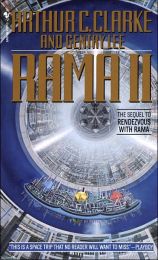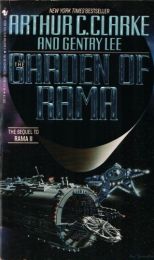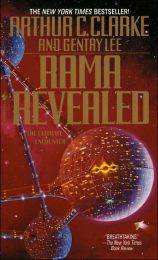
|

|

|
| Click an image to link to its review. |
One of the science fiction novels written by Arthur C. Clarke was A Rendezvous with Rama. Published in 1973, it depicts the arrival in the solar system of a gigantic cylindrical spacecraft of unknown origin, designated "Rama" by the naming system of the time. It appears in 2130, a time when humanity has learned to travel routinely throughout the solar system. Of course an expedition is mounted and a brief exploration of that spacecraft is achieved. The humans encounter many wonders before they have to leave. They watch Rama plunge inward past the Sun, apparently drawing sustenance from it, before heading outward on its unknown mission. One sentence at the end of the novel suggests that humanity will have another chance to unravel these mysteries.
"And on far-off Earth, Dr. Carlisle Perera had as yet told no one how he had wakened
from a restless sleep with the message from his subconscious still echoing in his brain:
The Ramans do everything in threes!"
That insight led to the writing of three more novels. Although Arthur C. Clarke's name is on them as lead author, it is likely they were entirely written by Gentry Lee, currently chief engineer for JPL's Planetary Flight Systems Directorate and a devout Catholic. These novels are:
Lee goes further, positing in Rama Revealed that the entire apparatus he shows us — Rama, other alien spacecraft, the Node, and constructs yet more immense he mentions — are tools created by God3 for the purpose of learning what factors make for a truly harmonious universe. And The Garden of Rama is a transparent retelling of the Garden of Eden story in which humankind is given a paradise and fouls it up. All this is too doctrinaire for my tastes.4
Reaction to these collaborative Rama novels is very much a mixed bag. I have heard that many people don't like them at all. The complaints on Amazon bear this out, running along the lines I've mentioned: too many sex scenes; too long-winded and boring; flat characters.

 To contact Chris Winter, send email to this address.
To contact Chris Winter, send email to this address.